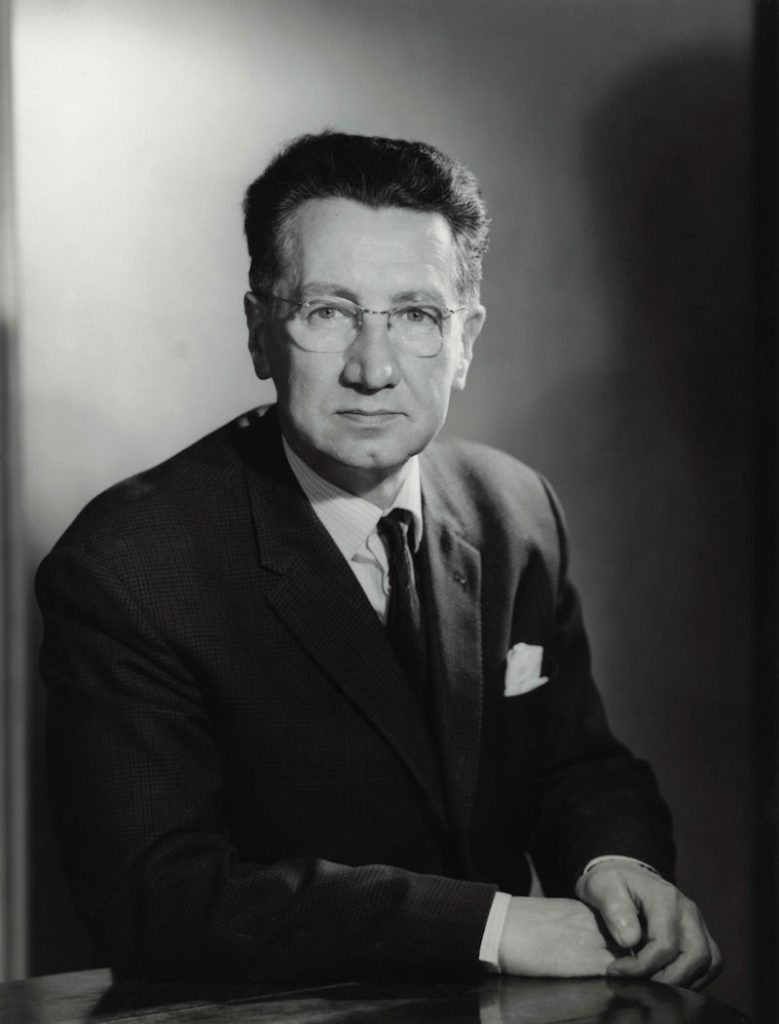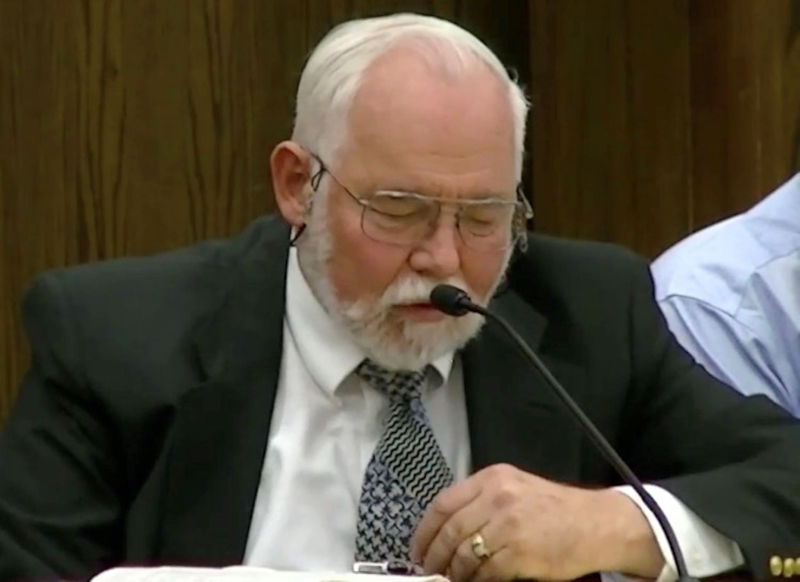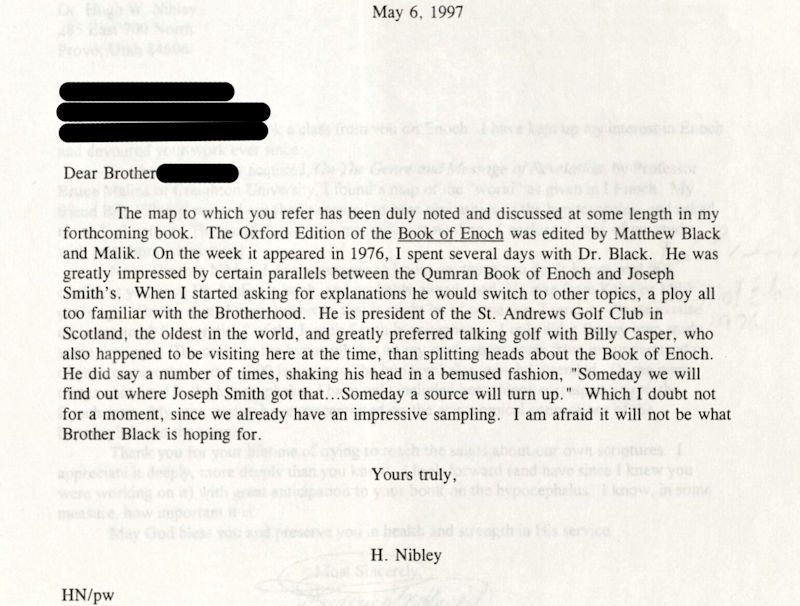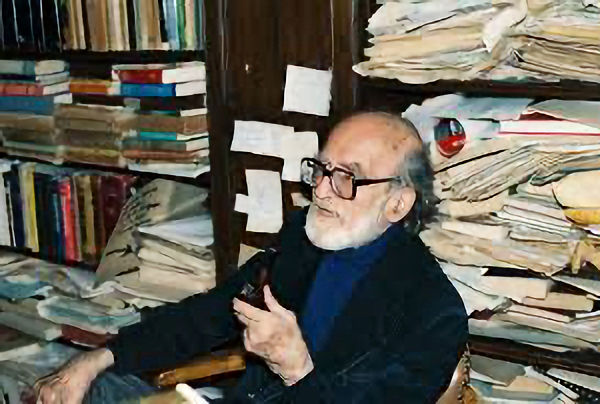Abstract: As a graduate student, Gordon Thomasson had the opportunity to introduce two internationally renowned scholars to the publications and scholarship of Hugh Nibley: Matthew Black, an eminent scholar of ancient Enoch writings; and Mircea Eliade, famed chair of the History of Religions program at the University of Chicago. Upon hearing of Nibley’s Enoch discoveries, Black made an immediate, impromptu visit to BYU to meet him. Upon reading one of Nibley’s studies, Eliade proposed hiring him on the spot, exclaiming, “He knows my field better than I do, and his translations are elegant!”
[Editor’s Note: Part of our book chapter reprint series, this article is reprinted here as a service to the Latter-day Saint community. Original pagination and page numbers have necessarily changed, otherwise the reprint has the same content as the original.
See Gordon C. Thomasson, “Matthew Black and Mircea Eliade Meet Hugh Nibley,” in Hugh Nibley Observed, ed. Jeffrey M. Bradshaw, Shirley S. Ricks, and Stephen T. Whitlock” (Orem, UT: The Interpreter Foundation; Salt Lake City: Eborn Books, 2021), 423–432. Further information at https://dev.interpreterfoundation.org/books/hugh-nibley-observed/.]
Matthew Black1

Figure 1. Matthew Black (1908–1994). “Waiting until the last of the lecture crowd had disappeared, I asked Professor Black if he was familiar with Joseph Smith’s Enoch text. He said he was not but was interested.” 10
I left BYU in 1968 after suffering, as a passenger, in six months’ time what normally would have been two fatal automobile accidents. Already having been admitted to University of California, Santa Barbara, [Page 72]Professor Nibley told me that if I came back to complete advanced degrees in religion at BYU he would never speak to me again, because I “would have nothing to say” (Hugh then made an explicitly pointed critique of academic inbreeding in BYU religion at the time). During the rest of my graduate studies elsewhere, I stayed in contact with him through various means, primarily because I still sporadically worked on Brigham Young materials we had researched together. My other responsibilities to him [Page 73]at BYU had included my subsequently continuing study and critiques of both Latter-day Saint apologetics for the Book of Mormon (a never-completed thesis) and of temple-related ritual texts across cultures and through world history. I also continued to follow his other research.

Figure 2. Gordon Thomasson participates in a panel discussion at the “Enoch and the Temple” conference, BYU, February 22, 2013.”11
Among other projects, Hugh continued to publish serially on aspects of the Pearl of Great Price, first focusing on Abraham and then on Enoch. The Enoch research appeared in the Ensign magazine as “A Strange Thing in the Land: The Return of the Book of Enoch” (1976–1977). Some of these and others of his writings on Enoch later appeared with slightly altered content in Enoch the Prophet.2 Latter-day Saint interest in the study of these texts continues.3
After I left BYU, Terrell M. Butler, a fellow graduate student at Cornell, invited me to join him in attending a guest lecture there that was to be given by Matthew Black. [Professor Black had collaborated with Józef Milik in the first translation of the Aramaic fragments of the Book of Giants into English in 1976.4 The Book of Giants, one of the oldest extant Enoch texts, had been found at Qumran among the Dead Sea Scrolls in 1948.]
Professor Black had come to the United States to take up residence at Princeton’s Institute for Advanced Study (1977–1978) and had been [Page 74]invited to Cornell to discuss his research on Enoch, including especially the Qumran sources and later correlations. I had no particular expectations until Professor Black advanced his conclusion that those Enoch texts were part of a genuine tradition and predated Genesis, that Moses had drawn upon those Enoch sources in creating Genesis, and that certain carefully clandestine groups had, up through the Middle Ages, maintained, sub rosa, an esoteric religious tradition based in the writings of Enoch, at least into the time of and influencing Dante.
I should note that at that time I had more or less firmly in memory a series of clear differences Hugh had shown between 1 Enoch (the 1821 Laurence text, at least available in theory to Joseph Smith),5 the clearly distinct “Extracts,” which the Prophet had published (1832), and later Enoch texts discovered after 1844.6
I had elsewhere explored the concept of text availability, beginning in the 1960s, using what I then defined as an “information environment” (consisting of what hard evidence shows could have been known from manuscripts, inscriptions, and so forth at a given time and place on a specific topic or text).
Waiting until the last of the lecture crowd had disappeared, I asked Professor Black if he was familiar with Joseph Smith’s Enoch text. He said he was not but was interested. He first asked if it was identical or similar to 1 Enoch. I told him it was not and then proceeded to recite some of the correlations Dr. Nibley had shown with Milik and Black’s own and others’ Qumran and Ethiopic Enoch materials. He became quiet. When I got to Mahujah (Moses 7:2), he raised his hand in a “please pause” gesture and was silent.
Finally, he acknowledged that the place-name of Mahujah could not have come from 1 Enoch. He then formulated a hypothesis, consistent with his lecture, that a member of one of the esoteric groups he had described previously must have survived into the nineteenth century, and hearing of Joseph Smith, must have brought the group’s Enoch texts to New York from Italy for the Prophet to translate and publish. I did not argue the point that the Book of Moses might not have been available in Europe in time for someone to sail to the United States and get to upstate New York to meet a late 1830 (or even 1832) “publication deadline.”
At the end of our conversation he expressed an interest in seeing more of Hugh’s work. I proposed that Black should meet with Hugh, gave him the contact information, and he contacted Hugh the same day, as Hugh later confirmed to me. Soon he made a previously unplanned [Page 75]trip to Provo where he met with Hugh for some time and also gave a public guest lecture but, as I was told, in that public forum would not entertain questions on Moses.

Figure 3. Here Nibley summarized his conversations with Professor Matthew Black on the Book of Moses Enoch account during Black’s 1976 visit to BYU.12
While Hugh subsequently told me the two of them enjoyed a long, private conversation (oh, to have been a fly on the wall!), Black, however, refused to entertain any questions about the Latter-day Saint scriptures in his public lecture.
[Editor’s note: Hugh Nibley also recorded an account of his interactions with Matthew Black during the latter’s 1976 visit to BYU. The account included a conversation with Black that apparently occurred near the end of the visit. Nibley asked Black if he had an explanation for the appearance of the name Mahujah in the Book of Moses and reported his answer as follows: “Well, someday we will find out the source that Joseph Smith used.”7]
Mircea Eliade8
A plush offer to Mircea Eliade of a visiting position in the Department of Religious Studies at the University of California, Santa Barbara, during our winter quarters, combined with his lack of interest in spending those [Page 76]same winter months in Chicago, brought me into contact with him both as a student in a graduate seminar and as the graduate assistant for his advanced undergraduate seminar.

Figure 4. Mircea Eliade (1907–1986). “He sat me down and asked, ‘Who is this Hugh Nibley and why haven’t I ever heard of him?’ and so forth. ‘He knows my field better than I do,’ Eliade continued, ‘and his translations are elegant.’”13
Eliade’s methodology in dealing with archetypes was, at its best, subjective (as all methodologies must be). But it had its publicly recognized downside as well. Some common criticisms of Eliade’s work included his being highly reliant on secondary sources and on translations for the countless texts he employed from outside the Indo-European tradition (in many Indo-European languages—including Sanskrit—he was quite able) and for presenting as parallels or archetypes images that could only be sustained when taken out of context or given in translation. Moreover, when pressed as to how archetypal resemblances were shared among peoples and cultures, Eliade verbally admitted that as far as he could tell the archetypes had to be based in a common genetics. This raises far more problems than it can ever answer, of course. As a result, I believe, he avoided questions of cultural diffusion about which other Europeans—unlike most North Americans, especially in the field of cultural anthropology—are quite open.
I witnessed something with Eliade when I worked in his undergraduate seminar that term. We did not have a clear thread visible [Page 77]in the syllabus as to where he was headed, but I began to see the red line of Ariadne’s clue running through his seminar in the direction of Nibley’s article “The Expanding Gospel.”9 The next week, at the end of the seminar, I gave Eliade a copy of that article and suggested that he might find it relevant. The following week he was nearly jumping out of his skin and could hardly wait to shoo the undergrads out after class. Then he sat me down and asked, “Who is this Hugh Nibley and why haven’t I ever heard of him?” and so forth. “He knows my field better than I do,” Eliade continued, “and his translations are elegant.”
I explained, among other things, that he published in the journals of a number of different disciplines outside the history of religions, depending on his research and the texts he was working on at the moment. We then spent the better part of an hour going over the article, and I noted to him as the discussion progressed, without being too explicit, where or how Latter-day Saint apologetic and esoteric subtexts ran through the article. He replied (paraphrasing here), “Who cares? His evidence and logic are faultless.”
He then went on to ask explicitly if he could hire Hugh to teach in his History of Religions program at Chicago. I said I didn’t think so, that he had unlimited book-buying power (the Jackling Fund) and all the library he needed where he was and that Hugh had already been at Chicago. “Impossible! I would have known him!” replied Eliade.
I then dropped what I knew was an explosive depth charge, thinking it might well end the discussion: “But he was at the Oriental Institute.” And Professor Anthon tore up the transcript . . . well, not quite. We continued the discussion, but not until after he had said, “You’re right, he wouldn’t fit in our program, I suspect.” (There was no love or academic respect between the Oriental Institute, which advocated the use of primary sources only, and Eliade’s History of Religions school, where a dissertation could be done using mainly secondary sources.)
Subsequently, however, at Eliade’s request, I spent the rest of the semester giving him copies of what I thought were the most appropriate Nibley articles. He devoured them in turn and then quizzed me about them after class each week, in case he had missed something. Eliade knew that all scholars have a bias. (Once, in an unguarded moment, he allowed that his Romanian Orthodox Christianity really was it.) More important to him in our discussions was how well scholars read and quote (in context), translate, use logic, or, in other words, play by the rules. Only his return to Chicago ended our private “seminar.”
[Page 78]In my direct, personal experience and at my invitation, other research university and world-class scholars have, like Black and Eliade, read and given very positive ratings to Nibley’s work when it has overlapped their own and when I submitted it for their consideration with no preface other than “What do you think of this?”
[Page 79]For a detailed report of new findings that build on Nibley’s pioneering research on resemblances between Mahijah/Mahujah in the Book of Moses and Mahaway/Mahawai in the Dead Sea Scrolls Book of Giants, see Jeffrey M. Bradshaw, Matthew L. Bowen, and Ryan Dahle, “Where Did the Names ‘Mahaway’ and ‘Mahujah’ Come From?: A Response to Colby Townsend’s ‘Returning to the Sources,’” Interpreter: A Journal of Latter-day Saint Faith and Scholarship 40 (2020): 181–242. https://journal.interpreterfoundation.org/where-did-the-names-mahaway-and-mahujah-come-from-a-response-to-colby-townsends-returning-to-the-sources-part-2-of-2/.
For more on the Book of Moses story of Enoch, including up-to-date research on its relationship to ancient sources, see Jeffrey M. Bradshaw, Enoch and the Gathering of Zion: The Witness of Ancient Texts for Modern Scripture (Orem, UT: The Interpreter Foundation; Srpingville, UT: Book of Mormon Central; Tooele, UT: Eborn Books, forthcoming 2021).
For an in-depth survey of current scholarship outlining evidence on sources for the Book of Moses in antiquity, see Jeffrey M. Bradshaw, David Rolph Seely, John W. Welch, and Scott Gordon, eds. Tracing Ancient Threads in the Book of Moses (Orem, UT: The Interpreter Foundation; Springville, UT: Book of Mormon Central; Redding, CA: FAIR; Tooele, UT: Eborn Books, forthcoming 2021).



Go here to see the one thought on ““Matthew Black and Mircea Eliade Meet Hugh Nibley”” or to comment on it.